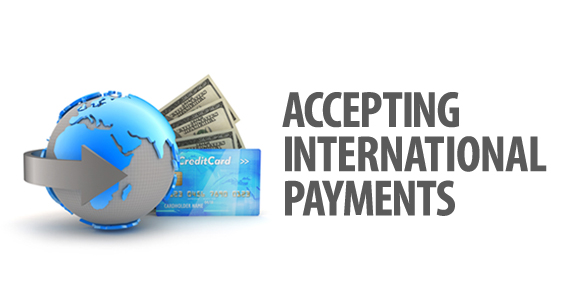 Making the decision to sell internationally can be a thrill – but for first-timers, figuring out how to process international payments can be daunting, to say the least. The good news is that there are lots of options for e-commerce sellers, and many tools are available to make global sales easier for both international buyers and sellers. Here’s a quick look at potential problems and solutions.
Making the decision to sell internationally can be a thrill – but for first-timers, figuring out how to process international payments can be daunting, to say the least. The good news is that there are lots of options for e-commerce sellers, and many tools are available to make global sales easier for both international buyers and sellers. Here’s a quick look at potential problems and solutions.
Do U.S. Merchants Accept International Payments?
For the most part, no – for the simple reason that international payments are subject to higher processing fees due to the risk of fraud and chargebacks. For that reason, if you plan to work with customers in different countries, you’ll likely need to set up an additional account for those orders. (For a list of merchant accounts and payment processors that accept international payments, click here.) Luckily, there are lots of other options for e-commerce sites like yours.
What is an International Merchant Account?
Marketed by banks and payment-processing companies, International Merchant Accounts provide e-commerce owners with a variety of solutions specifically geared toward small businesses. These usually include automatic acceptance and processing of payments, payment-trend tracking and fraud prevention. Because international accounts directly accept payments from around the world, they’re an alternative to payment aggregators like PayPal, and in some cases give buyers the perception of a larger and more established business. As a rule, International Merchant Accounts provide reasonable currency exchange rates as part of their fees.
How Do I Open an International Merchant Account?
Once you’ve determined if the merchant account provider allows international transactions (you’ll also want to compare fees with other merchant accounts and evaluate extra services offered before making your final choice), you’ll pay an initial set-up fee in order to obtain the processing equipment and/or software. After you install the software and establish your account information, link the merchant account with your business bank account. The money received via the International Merchant Account will be automatically converted to U.S. dollars when it’s transferred to your business account. (See “Show Me the [International] Money!” below.)
To link the payment service with your website or marketplace storefront, follow the instructions provided by the service to create your checkout process. Most vendors provide simple HTML or javascripts including customization that you can add to your checkout process as part of the set-up fee.
PayPal
Probably the best-known payment processor for online sellers, PayPal operates in 190 international markets and accepts payment in 24 different currencies – and it doesn’t require a merchant account to operate. Transaction fees are usually lower than bank fees, transactions are quick and secure, and because it only requires an email address to set up payment, customers find it easy to use as well as a snap to navigate. Free tools, including shipping and tracking reports, give you a lot of bang for your buck, too.
On the other hand, those bucks can add up, thanks to PayPal’s famous fees. In addition to monthly fees, expect to be charged for transaction, withdrawals and currency conversion, just to name a few. If you find you can’t absorb some of the fees into your product prices or that the extras aren’t worth the expense, there are less-expensive options available without all the bells and whistles (see “Other International Payment Options,” below).
Show Me the (International) Money!
Once you’ve decided on the payment option that works best for your business’ needs, here’s what to expect regarding receiving your funds via an International Merchant Account or payment processor.
- International Merchant Accounts. Once you set pricing for your international customers in the currencies you choose to accept, you’ll receive payment in U.S. dollars or the currency of your choice to your local bank account within 2 business days. If you find yourself regularly doing international business, consider an account that includes a dedicated chargeback department as part of its package.
- PayPal. If payment comes in the default currency you chose while setting up your PayPal account preferences, your payments will be automatically updated, typically within 3 to 4 days. If it’s a currency you chose not to accept, you’ll have the option of accepting it as is, converting it at the standard rate, or denying it. To account for currency fluctuations, PayPal monitors the foreign exchange rate and adds 2.5 percent to the transaction; when you move funds from your PayPal account to your local bank account, the currency exchange rate will be the one used at the time of that transaction.
Other International Payment Options for Your Store
If the popular methods described above don’t suit your needs, here are some traditional payment options to consider, some of which predate the surge in popularity in e-commerce but are still available.
- Individual credit card firms. You may also choose to work directly with merchant accounts such as Visa, MasterCard, AmEx, and other major credit companies, but since these firms are separate entities, your international buyers’ options are limited, which could cost you sales.
- International money orders. Your international customer can purchase these right from their local bank, and because the bank requires a photo ID and signature, they’re considered secure. Fees are generally small, but the payment process can take up to 10 days. One very important issue: Fraud is a huge problem with international money orders!
- International wire transfers. If you have an established relationship with a customer, international wire transfers are usually quick. However, they’re expensive – costing between $35 and $60 per transaction – and not easily traceable, so settling disputes can get complicated.
- Irrevocable Letters of Credit (ILOC) can be useful in cases in which you aren’t familiar with the international customer. Correspondence issued by a bank guaranteeing payment of goods, ILOCs offer assurance from the financial institution that the transaction can’t be cancelled under any circumstance within the stated time period.
- Google Wallet (formerly Google Checkout), currently available in limited countries, uses Google’s familiar interface and ubiquitous online presence, but some popular online marketplaces, like eBay, have been slow to accept it.
- Telegraphic Transfers between banks have been in use for decades, but their popularity is waning in light of newer and more convenient payment options. eBay, for example, restricts their use to specific items, such as automotive or heavy equipment.
- Personal check. Accept at your own risk! As a protective measure, major marketplaces discourage or prohibit the use of personal checks. However, with your own website, you’re entitled to consider them on a case-by-case basis as long as you’re comfortable calculating your total on your own to include taxes, customs, currency exchange and other fees.






